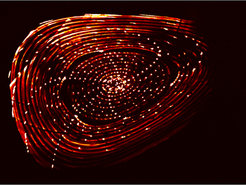Magnetic field of Wendelstein 7-X exact to a hundred-thousandth
Evaluation of magnetic field measurement / Overview in “Nature Communications”

The shape of the magnetic field needed in the Wendelstein 7-X stellarator fusion device was achieved to a precision of a hundred-thousandth. This evaluation of the first physical results with the new machine – these having been achieved before Wendelstein 7-X went into operation at Max Planck Institute for Plasma Physics in Greifswald in December 2015 – appeared today in the online journal, “Nature Communications”.
The article describes the scientific path to the complex field structure of Wendelstein 7-X tailored for good confinement of the plasma. How precisely the field structure needed – a setup of closed magnetic surfaces nested in one another – can be generated by the specially shaped superconducting stellarator coils is now clear. Deviations from the calculated target shape are within a hundred-thousandth: A magnetic field line traced for a distance of 100 metres, i.e. the extent of a football pitch, will be spot on target to within a millimetre.
This was confirmed with a highly sensitive measuring method: For this purpose, a thin electron beam is injected and moves along a field line in circular tracks through the evacuated plasma vessel. If a fluorescent rod is moved through the vessel cross-section, light spots are created when the electron beam hits the rod. In the camera recording, the structure of the magnetic field gradually becomes visible – the expected elliptical surfaces nested in one another.
Proof of exact magnetic surfaces thus achieves the first aim of Wendelstein 7-X. There are, however, many questions that still have to be answered by the Wendelstein 7-X team to clarify whether the stellarator is the right concept for fusion energy: “That task”, according to the authors, “has just started”.
